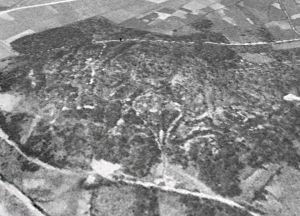Des fouilles préalables aux travaux de réaménagement de la place de l’église d’Oiron ont révélé la présence de nombreux ossements.
Deux tranchées devant l'église collégiale d'Oiron ont réservé aux archéologues d'intéressantes découvertes. Le diagnostic préalable aux travaux de réaménagement de la place des Gouffier a mis au jour de nombreux ossements particulièrement bien conservés, notamment d'enfants, révélant la présence d'un cimetière, probablement avant la construction de l'édifice du XVIe siècle.
Annie Bolle, archéologue, relevait hier la présence d'épingles qui attestent que les corps ont été inhumés dans des linceuls, et de clous provenant de cercueils. Elle soulignait également que les corps avaient été disposés de manière très organisée : l'espace, restreint, a été optimisé. Découverte plus rare : les archéologues ont eu la chance de retrouver parmi les ossements des perles de chapelet.
A l'issue de ce diagnostic archéologique, terminé vendredi, une commission déterminera si le site nécessite des fouilles plus approfondies. Ce qui n'arrangerait pas la commune, qui devrait retarder ses travaux et payer les recherches.
« Le mieux serait de les laisser reposer en paix », commente le maire d'oiron, Gilbert Lang, qui espère boucler le réaménagement de la place d'ici la fin de son mandat, l'an prochain. Les travaux, entamés pour une première tranche – depuis la rue du Château –, prévoient une place séparée en deux par un muret surplombé de planches de bois où s'asseoir. La partie haute restera minérale, tandis que l'espace devant l'église sera pavé, jusqu'à l'accès au domaine viticole.
http://www.lanouvellerepublique.fr/Toute-zone/Loisirs/Patrimoine-tourisme/n/Contenus/Articles/2013/03/30/Un-ancien-cimetiere-au-pied-de-la-collegiale-d-Oiron-1391782
Annie Bolle, archéologue, relevait hier la présence d'épingles qui attestent que les corps ont été inhumés dans des linceuls, et de clous provenant de cercueils. Elle soulignait également que les corps avaient été disposés de manière très organisée : l'espace, restreint, a été optimisé. Découverte plus rare : les archéologues ont eu la chance de retrouver parmi les ossements des perles de chapelet.
A l'issue de ce diagnostic archéologique, terminé vendredi, une commission déterminera si le site nécessite des fouilles plus approfondies. Ce qui n'arrangerait pas la commune, qui devrait retarder ses travaux et payer les recherches.
« Le mieux serait de les laisser reposer en paix », commente le maire d'oiron, Gilbert Lang, qui espère boucler le réaménagement de la place d'ici la fin de son mandat, l'an prochain. Les travaux, entamés pour une première tranche – depuis la rue du Château –, prévoient une place séparée en deux par un muret surplombé de planches de bois où s'asseoir. La partie haute restera minérale, tandis que l'espace devant l'église sera pavé, jusqu'à l'accès au domaine viticole.
http://www.lanouvellerepublique.fr/Toute-zone/Loisirs/Patrimoine-tourisme/n/Contenus/Articles/2013/03/30/Un-ancien-cimetiere-au-pied-de-la-collegiale-d-Oiron-1391782










.jpg)
.jpg)


.jpg)


































